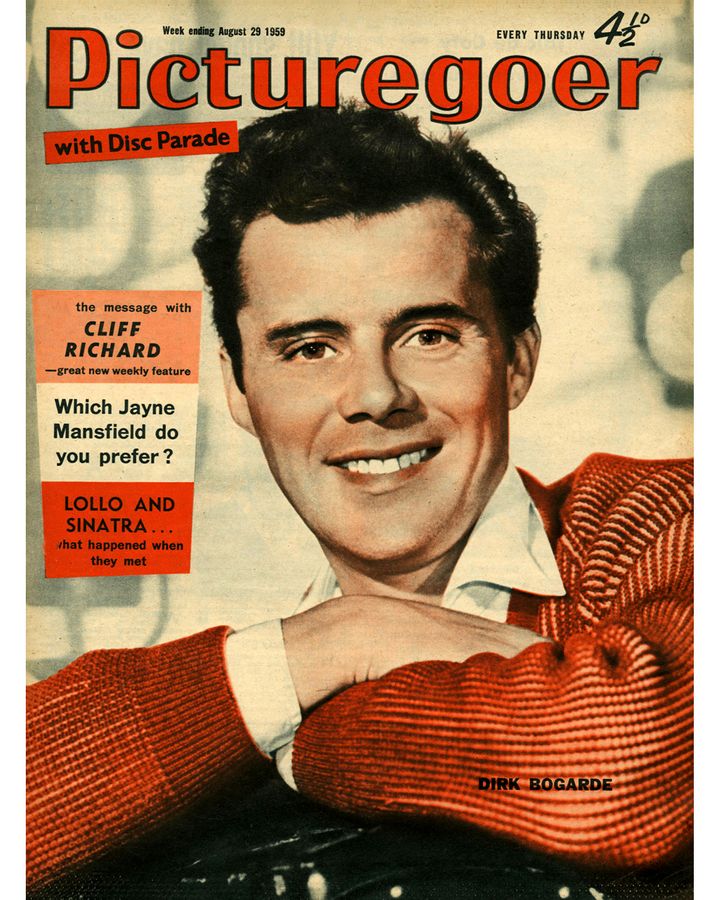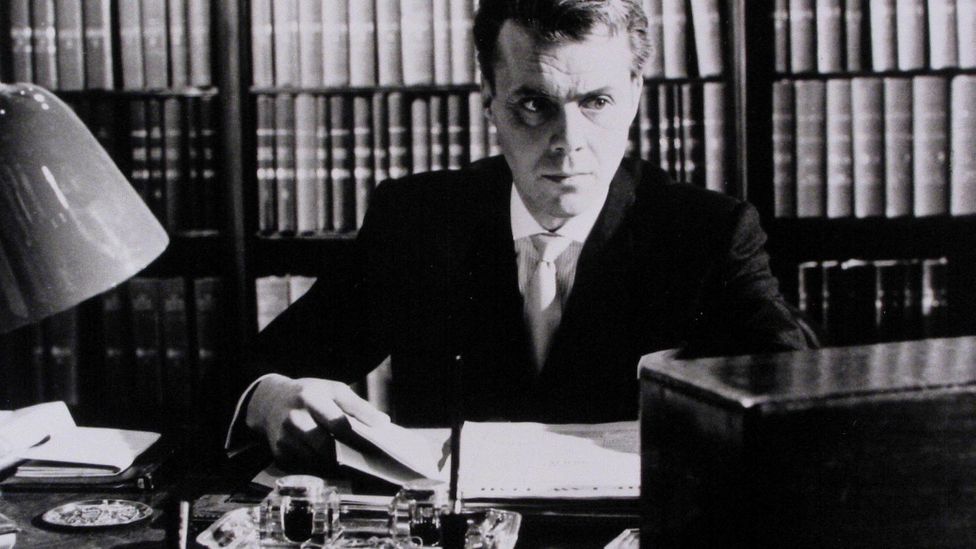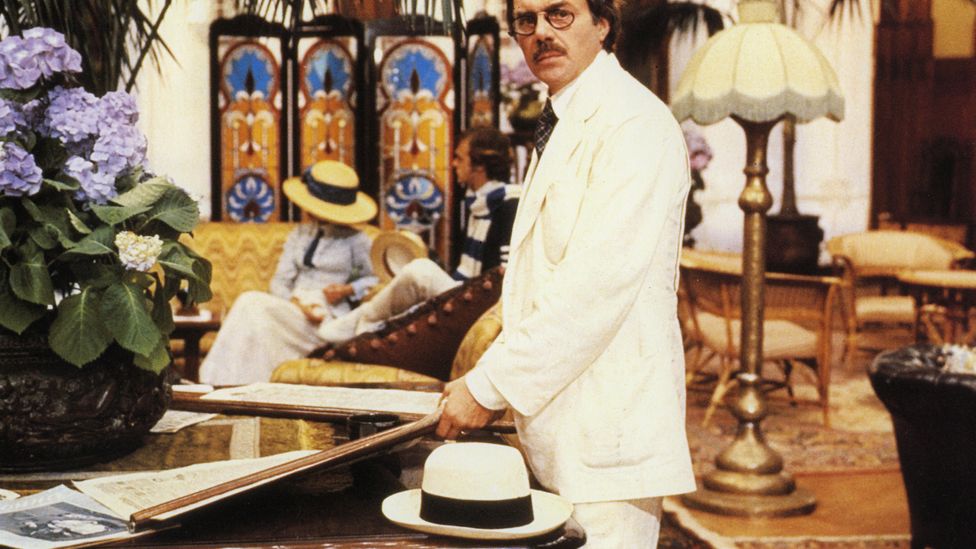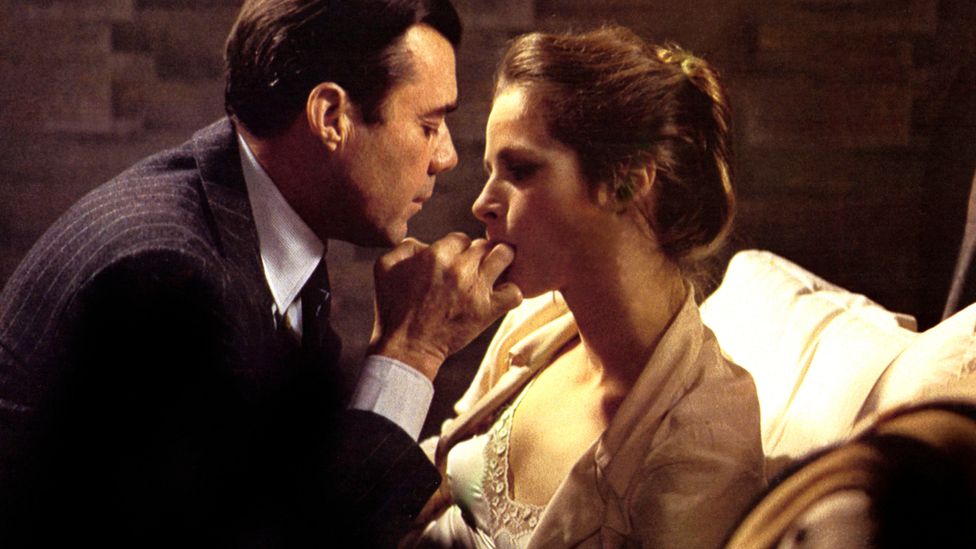Sir Dirk Bogarde ‘A Dangerous Actor’ Plays a Gay Man When It was Illegal to be Gay
Many actors have undergone transformations, from Olivia Colman morphing from a British sitcom mainstay into a serious actress of international repute, to Robert DeNiro trading method-actor intensity for jovial fare like Meet The Fockers – but no-one has made quite such a provocative career turn as Dirk Bogarde. The British actor had two distinct phases: from 1948 he lit up screens as a dashing matinee idol, and then, from 1961, he chose roles that challenged received morality and that pushed the scope of cinema. All the while, he stayed alive to the world beyond his forcefield, as revealed by the entertaining letters he wrote to everyone from collaborators to random penpals.

Bogarde became a pin-up in the 1950s thanks to his role as dashing medic Simon Sparrow in the Doctor film series (Credit: Alamy)
As we approach the centenary of his birth this weekend, it's interesting to reflect on a unique star whose legacy is a clarion call to pursue creative freedom. By the time he became an actor he had experienced enough of the heaviness of life to take fame lightly. In other words: he didn’t believe his own hype, even though there sure was a lot of it not to believe.
The crowd-pleasing early days
"Presenting Britain's most popular star" shouts the trailer to the 1958 Charles Dickens adaptation A Tale of Two Cities, cutting to a figure who is every inch the romantic gentleman with a cravat, top hat and furrowed brow: "Dirk Bogarde as Sydney Carton".
Bogarde was, as his official biographer John Coldstream tells BBC Culture, "box-office catnip" and had been since 1954's Doctor in the House, a lightweight comedy about hijinx in a London hospital. Bogarde was cast as shy medical student Simon Sparrow, a role he played a further three times in Doctor At Sea (1955), Doctor At Large (1957), and Doctor in Distress (1963). His Simon is quietly dashing, a soulful presence in contrast with brasher peers, whose nurse-ogling is played for laughs and so has not aged well. Sparrow captured the public imagination, and it was rare to find a film magazine in the 50s that didn't feature Dirk frowning under a soft forelock of dark hair. Contracted to British studio The Rank Organisation since 1948, he was busting out movies at a rate of three to four a year, and his status seemed set as a crowd-pleasing A-lister. He had been an above-the-title name since playing a seductive footman in Esther Waters (1948), and by the early 1950s, he was a big face in the celebrity industrial complex, placing highly in best movie star polls – indeed, as relayed by Coldstream in his biography, Olwen Evans, a shorthand typist from Kent "won" a date with Bogarde, in the Daily Mirror's Teen Queen contest.
Then, in 1961 with his contract at Rank coming to an end, Bogarde took the role of barrister Melville Farr in Basil Dearden's Victim, a black-and-white thriller about gay men being blackmailed under threat of exposure and jail time, which was made six years before the Sexual Offences Act decriminalised "homosexual acts in private between consenting adults" in the UK. Under the original working title Boy Barrett, Jack Hawkins was cast as Farr. He backed out, and the part was turned down by two more actors, James Mason and Stewart Granger, before the idea dawned on Pinewood bigwig, Earl St John, to offer it to Bogarde. In a letter written by Victim's producer Michael Relph to its co-writer Janet Green at the time, Relph notes: "In spite of the obvious dangers for [Bogarde], he jumped at it."
He knew his box-office appeal would suffer. But by that time, he'd said, 'Come on, I just want to make the work I want to make' – John Coldstream
The obvious danger was that Bogarde was gay and living with his partner Anthony 'Tote' Forwood, as he would until Forwood died in 1988. "This was a way of getting out a message" says Coldstream. "He couldn't go on a chat show and say, 'Look, I'm living with Tony Forwood'". Victim was the first British film to use the word "homosexual", and it played a role in helping the 1967 Sexual Offences Act through its 10-year gestation period. Lord Arran, who introduced the legislation that would become the act, wrote to Bogarde in 1968 praising his "courage in undertaking this difficult and potentially damaging part", adding "It is comforting to think that perhaps a million men are no longer living in fear".
Back in 1961, on the film's release, the prospect of covering it was not a straightforward matter for critics. Press baron Lord Beaverbrook, owner of The Daily Express, Sunday Express, Evening Standard and The Scottish Daily Express, all but banned the mention of homosexuality in his titles, especially in a sympathetic context. The Evening Standard's lead film critic Alexander Walker was told by his deputy editor "I'd ignore it if I were you." Walker did not ignore it. "At last, after years of playing paper-thin parts in paperweight films, Dirk Bogarde has a role that not only shows what a brilliant actor he is – but what a courageous one he is, too," he wrote. Other impressed reviews rolled in, as did a new kind of audience, more critical, less popular. "He knew his box-office appeal would suffer," says Coldstream. "But by that time, he'd said, 'Come on, I just want to make the work I want to make'".The film ushered in a new and compelling era of Bogarde, by then aged 40 – the Bogarde that cinema-lovers still think of today.
 |
He wasn't interested in Hollywood and perhaps Hollywood wasn't interested in him, although he dabbled, starring opposite Ava Gardner in 1960 war drama The Angel Wore Red. Instead, there was a mutual attraction between him and auteurs. One of these was Joseph Losey, whose 1963 film The Servant is an immaculately crafted exploration of the power struggle between the wealthy and clueless Tony (James Fox) and his Machiavellian manservant Hugo Barrett (Dirk). The film was scripted by Harold Pinter, and Bogarde filled those famous Pinter pauses with crafty looks galore. "He conveyed thought and people read his thoughts," said his co-star Fox in a the 2000 instalment of the British TV documentary strand Legends devoted to Bogarde. Tension between the two characters burns slowly, until a climax executed with merciless triumph by Barrett.
A motif across Bogarde performances is the capacity to show naked cruelty – all bone, no meat; all blade, no sheath. 1967's Accident, another Bogarde-Losey-Pinter collaboration, is so full of dread that it is nearly unbearable. Bogarde worked with Losey a total of five times (1954's The Sleeping Tiger, 1964's King and Country and 1966's Modesty Blaise were the other three) and had an extensive correspondence with both Losey and Losey's wife, Patricia. Bogarde often had a tone of brotherly exasperation at his friend and collaborator's downbeat nature. "Life is'nt [sic] all that bad, Joe. It can, actually, be fun if you try!" went a postcard dated 16 October 1969 from Villa Berti in Rome, where Bogarde and Forwood had just relocated from the UK.
His European era
The Losey films marked the start of Bogarde's dive into the more shadowy side of human nature. Once installed in Italy, he worked twice with Luchino Visconti, first on The Damned (1969), and then on Death in Venice (1971). The latter, an adaptation of the Thomas Mann novella, evidences Bogarde's mastery of micro-acting via finickity movements, flare ups of quickly quelled distress, and even the pompous way he eats a strawberry. His sickly composer Gustav Von Aschenbach (based on Gustav Mahler, whose music forms the score) is adrift and alone as he indulges a silent obsession with Tadzio, the embodiment of youth and beauty in the Mann original, lent an overt sexual gauze in Visconti's adaptation. This is particularly troubling in light of the abuses Bjorn Andreson, the 14-year-old Swedish actor playing Tadzio, suffered afterwards, as chronicled in a new documentary, The Most Beautiful Boy in the World – the title that Visconti ascribed to his teenage star while they were promoting Death in Venice at the 1971 Cannes Film Festival.
For his part of Von Aschenbach, who has fled to Venice after tragedy and humiliation, Bogarde's dialogue is mainly choleric outbursts at hotel staff. Otherwise, his face performs a mute dance of longing and regret; life flashing before his eyes and amounting to less than the flesh and blood boy before him. For the finale, he has a make-over in the clownish bourgeois manner of the time: all white face powder, rosy lips and jet-black hair. As the wretched von Aschenbach lies in a deckchair, dye sweating down his face, it's hard to recall the clean-cut matinee idol who launched a thousand magazine covers. Bogarde did this to himself whole-heartedly, writing to Visconti afterwards: "It seems incredible to me that the film is over only by a few weeks… I am very nostalgic for it and for Gustav... and always for you."
Every actor has his own inner orchestra, a kind of expressive instrumentation that can be very rich, which was the case with Dirk – Liliana Cavani
The most divisive – and, indeed, my favourite – Bogarde film was yet to come. There could scarcely be a more controversial subject than that of Liliana Cavani's The Night Porter (1974). Set in 1957, it sees Bogarde play Max, a night porter in a Viennese hotel, living quietly, hiding from his past identity as a Nazi officer. One day, concentration camp survivor, Lucia (Charlotte Rampling), visits the hotel and they rekindle a sadomasochistic relationship that began in the camp. What sounds from its top-line like poor-taste pornography is infused with strange powers: although Lucia should hate Max, he makes sense to her somehow. Neither character can move on from this one indelible moment in history which binds them together in abjection.
 |
Cavani had been impressed by Bogarde in The Servant, she tells BBC Culture: "He gave a performance made of subtlety and skill so, when I was able to make my film, I wanted only him." She was taken by her agent to meet Bogarde at his home, which was now on the Côte d'Azur in France, and realised she had truly found her Max. "He was indeed my protagonist; he exuded intelligence, curiosity and restlessness." There followed a night of enviable bonding and excess. "I had a child's command of English, so we spoke French to each other the whole evening, over dinner and whisky afterwards. On the way back to the airport my agent asked what we had discussed. I told her we had drunk a bit, but with all the lucidity I could muster I declared that he was my main character. The next day he couldn't really remember the conversation either but he agreed to do the film."
Bogarde and Rampling were equally well cast, sharing a deep magnetism. "Every actor has his own inner orchestra, a kind of expressive instrumentation that can be very rich, which was the case with Dirk," says Cavani, "Without Dirk's inner richness – and Charlotte Rampling's as well – my film might have become a turbid little story. Instead, Dirk and Charlotte went deep into their characters, holding on to them so tightly, they almost lost themselves."
He was for me a good and great man, but he wasn't a goody-goody, that's for sure – Charlotte Rampling
The idea for these characters had fermented in Cavani over time, fuelled by the years she has spent mired in research for other projects: both watching "kilometres of film" on the Third Reich for La Storia del Terzo Reich, a four-episode series broadcast on Italy's RAI TV from 1965-66, and conducting interviews herself for her one-off 1965 documentary on the same channel, La donna della resistenza, about women who had participated in the Resistance struggle. "I interviewed two partisan women who had survived the concentration camps, one in Dachau and the other in Auschwitz," says Cavani. "The Dachau survivor was a teacher from Cuneo who went to Dachau during her holidays in order to not forget and to bear witness. The Auschwitz survivor had left her family and lived alone because she did not want to keep hearing the same advice: 'Forget everything!'"
Why did Dirk want to play a character defined by the most horrific act of the 20th Century? "He'd seen a lot of bad stuff," says Coldstream, referring to Bogarde's time in the Allied Forces during World War Two, when he visited the Bergen-Belsen concentration camp following its liberation. "The darker side of humanity had been unveiled to him and he knew how badly people could treat each other in life. He was shielded from a lot of that because he had a very happy relationship himself, but he was fascinated by the depths that people would go to."
 |
Bogarde's
In an interview for the Legends documentary, Charlotte Rampling says of Bogarde: "He was for me a good and great man, but he wasn't a goody-goody, that's for sure." Her mouth then curves in delight: "He was wicked." This is correct. He was irreverent and unshocked by taboos, drawn to edgy material, not to provoke, but to show a lesser-seen side of human nature. He regularly rejected praise that he was "brave" as he was driven by integrity, acting out his interests with an acid sense of humour, and choosing to collaborate with idiosyncratic greats who also included John Schlesinger (1965's Darling), Alain Resnais (1977's Providence), Rainer Werner Fassbinder (1978's Despair) and Bertrand Tavernier (1990's Daddy Nostalgie).
Across the final two decades of his life, before his death in 1999, the inveterate letter-writer almost gave up on acting, and instead turned to public penmanship in the form of six novels, ten memoirs, and wide-ranging forms of journalism. His writing is indecently great; crisp, funny, detailed and full of the feelings that powered his acting. After Forwood died from cancer in 1988, Bogarde became a book reviewer for The Telegraph at literary editor Nicholas Shakespeare's suggestion. "Nicholas didn't know it at the time , but it was he who chucked a plank across the ravine for me," wrote Bogarde in the introduction to his journalism collection For The Time Being, When Shakespeare moved on, it was Coldstream, in fact, who became Bogarde's editor. At the beginning of our call, Coldstream says simply of his old friend and colleague: "I miss him".
Looking back at his career inspires a sense of loss – not only for Bogarde as an actor, but for a personality that served higher ideals than box-office bottom lines, and deeper truths than a wipe-clean image. Perhaps the modern star most comparable to him is Robert Pattinson, who turned his back on mega stardom after the Twilight franchise to make strange, transgressive films with directors like David Cronenberg, The Safdie Brothers and Claire Denis. Still, Pattinson's choices are artistically niche with a side of nihilism, rather than morally challenging, and hence he is tame by comparison. There is no one today like Dirk Bogarde.
🌹
Love film and TV? Join BBC Culture Film and TV Club on Facebook, a community for cinephiles all over the world.
If you would like to comment on this story or anything else you have seen on BBC Culture, head over to our Facebook page or message us on Twitter.
And if you liked this story, sign up for the weekly bbc.com features newsletter, called The Essential List. A handpicked selection of stories from BBC Future, Culture, Worklife and Travel, delivered to your inbox every Friday.
Comments